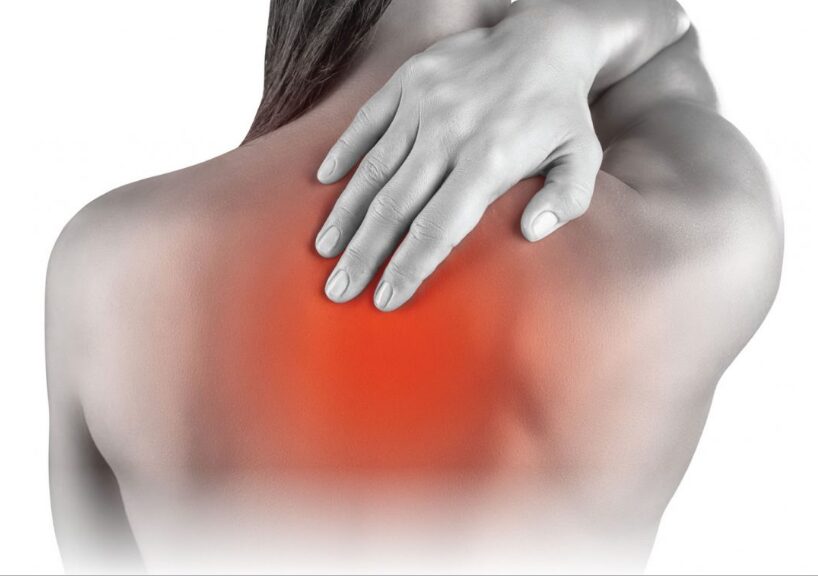What are the symptoms of upper back pain?
The symptoms of upper back pain can vary, but they often include:
- Dull or Aching Pain: Persistent discomfort or aching sensation in the upper back.
- Sharp or Stabbing Pain: Intense, sharp pain that may occur suddenly and feel localized.
- Muscle Tension: Tightness or stiffness in the upper back muscles, often accompanied by difficulty moving or bending.
- Radiating Pain: Pain that spreads from the upper back to the shoulders, neck, or arms.
- Limited Range of Motion: Difficulty or pain when trying to move the upper back, neck, or shoulders.
- Pain with Movement: Pain that worsens with certain movements or activities, such as lifting, twisting, or reaching.
- Numbness or Tingling: Sensations of numbness or tingling in the arms or hands, which may indicate nerve involvement.
- Headaches: Tension headaches or migraines that can be linked to upper back pain.
- Muscle Spasms: Involuntary contractions of the upper back muscles that cause pain and stiffness.
- Postural Issues: Pain related to poor posture or prolonged sitting, especially in positions that strain the upper back.
If the pain is severe, persistent, or associated with other symptoms like weakness, numbness, or difficulty breathing, it’s important to seek medical evaluation to determine the underlying cause and receive appropriate treatment.
What are the causes of upper back pain?
Upper back pain can be caused by a variety of factors, including:
- Muscle Strain: Overuse or excessive strain of the upper back muscles from activities such as heavy lifting, poor posture, or repetitive movements.
- Poor Posture: Prolonged periods of sitting or standing with poor posture, such as slouching or leaning forward, can strain the upper back.
- Herniated Discs: Displacement of intervertebral discs in the thoracic spine can press on nerves and cause pain.
- Spinal Stenosis: Narrowing of the spinal canal, which can put pressure on the spinal cord and nerves, leading to pain.
- Osteoarthritis: Degenerative changes in the spinal joints can cause pain and stiffness in the upper back.
- Rib Issues: Problems with the ribs, such as rib fractures or inflammation, can cause upper back pain.
- Scoliosis: Abnormal curvature of the spine can lead to uneven stress and pain in the upper back.
- Injuries: Trauma or injuries to the upper back from accidents, falls, or sports activities.
- Infections: Infections such as osteomyelitis or discitis can cause pain and inflammation in the upper back.
- Muscle Imbalance: Imbalance in muscle strength and flexibility between the upper back and other muscle groups can contribute to pain.
- Nerve Compression: Conditions that compress the spinal nerves, such as a herniated disc or bone spurs, can lead to pain in the upper back.
- Mental Stress: Emotional stress and anxiety can lead to muscle tension and pain in the upper back.
Addressing the underlying cause of upper back pain is crucial for effective treatment and relief. If pain is persistent or severe, seeking medical evaluation is important.
What is the treatment for upper back pain?
Treatment for upper back pain often depends on the underlying cause, but common approaches include:
- Rest and Activity Modification: Reducing or modifying activities that exacerbate the pain can help prevent further strain and allow healing.
- Heat and Cold Therapy: Applying heat or cold packs can reduce pain and inflammation. Heat can relax muscles, while cold packs can numb the area and reduce swelling.
- Pain Relief Medications: Over-the-counter pain relievers, such as ibuprofen or acetaminophen, can help manage pain and inflammation.
- Physical Therapy: A physical therapist can develop a personalized exercise program to strengthen the upper back muscles, improve posture, and increase flexibility.
- Stretching and Strengthening Exercises: Regular stretching and strengthening exercises can help alleviate muscle tension and prevent future pain.
- Posture Correction: Improving posture, especially if sitting or standing for long periods, can reduce strain on the upper back.
- Manual Therapy: Techniques such as massage or chiropractic adjustments can help relieve muscle tension and improve spinal alignment.
- Ergonomic Adjustments: Making changes to your workstation or daily activities to ensure proper ergonomics can prevent and alleviate pain.
- Lifestyle Changes: Incorporating regular physical activity, maintaining a healthy weight, and managing stress can contribute to overall back health.
- Medical Interventions: For more severe cases, medical treatments such as corticosteroid injections or prescription medications may be recommended.
- Surgery: In rare cases, when conservative treatments are ineffective and there is a structural problem, surgical intervention may be considered.
Consulting with a healthcare provider is important for a proper diagnosis and to determine the most appropriate treatment plan based on the specific cause of upper back pain.

Leave a Reply
You must be logged in to post a comment.